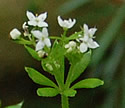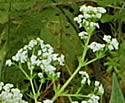Galium asprellum (Rough Bedstraw)
| Also known as: | |
|---|---|
| Genus: | Galium |
| Family: | Rubiaceae (Madder) |
| Life cycle: | perennial |
| Origin: | native |
| Habitat: | part shade, sun; wet; bogs, marshes, wet meadows, moist woods, thickets |
| Bloom season: | June - September |
| Plant height: | 2 to 6 feet |
| Wetland Indicator Status: | GP: OBL MW: OBL NCNE: OBL |
| MN county distribution (click map to enlarge): |  |
| National distribution (click map to enlarge): |  |
Pick an image for a larger view. See the glossary for icon descriptions.
Detailed Information
Flower: 

![[photo of flowers]](/udata/r9ndp23q/white/rough-bedstraw_0726_175834-t.jpg) Small branched clusters of several to many stalked flowers arising from leaf axils and at the ends of branching stems. Flowers are about 1/8 inch across with 4 white petals longer than wide and pointed at the tip.
Small branched clusters of several to many stalked flowers arising from leaf axils and at the ends of branching stems. Flowers are about 1/8 inch across with 4 white petals longer than wide and pointed at the tip.
Leaves and stems: 

![[photo of leaves]](/udata/r9ndp23q/white/rough-bedstraw_0726_175655-t.jpg) Leaves are mostly whorled in groups of 6, though branches may be whorled in 4s or 5s. Leaves are 1/3 to ¾ inch long, up to ¼ inch wide, generally elliptical but usually widest above the middle, with an abrupt sharp point at the tip. There are tiny downward pointing hairs around the edges and along the midvein on the underside. Stems are 4-sided with downward pointing hairs along the angles. Stems are weak and usually sprawling, using surrounding vegetation for support, and heavily branched.
Leaves are mostly whorled in groups of 6, though branches may be whorled in 4s or 5s. Leaves are 1/3 to ¾ inch long, up to ¼ inch wide, generally elliptical but usually widest above the middle, with an abrupt sharp point at the tip. There are tiny downward pointing hairs around the edges and along the midvein on the underside. Stems are 4-sided with downward pointing hairs along the angles. Stems are weak and usually sprawling, using surrounding vegetation for support, and heavily branched.
Fruit: 
Fruit is a pair of smooth round capsules, each less than 1/16 inch across and containing a single seed.
Notes:
Rough Bedstraw is aptly named. The downward pointing hairs on leaves and stems allow it to grab onto and stick to anything that passes by. It most closely resembles Fragrant Bedstraw (Galium triflorum), which has greenish flowers all grouped in 3s, and is mostly unbranched. Also similar is Cleavers/Sticky-willy (Galium aparine), which blooms much earlier, has longer, narrower leaves whorled in 6 to 8, few flowers in a cluster, fruit covered in hooked hairs, is primarily a woodland species, and is also few-branched.
Native Plant Nurseries, Restoration and Landscaping Services ↓
More photos
Photos by K. Chayka taken in Aitkin and Hubbard counties.
Comments
Have you seen this plant in Minnesota, or have any other comments about it?
on: 2017-06-02 14:46:08
Can you help me? I have this stuff all over a woodland and would like to get rid of it. I'm thinking of raking it out to limit the seed production. Do you have anything to recommend?
on: 2017-09-10 13:08:27
This popped up in my beds this year. Great groundcover, but a prolific self-seeder. oi







 Rough Bedstraw plant
Rough Bedstraw plant more plants
more plants Rough Bedstraw habitat
Rough Bedstraw habitat sticky stuff!
sticky stuff!